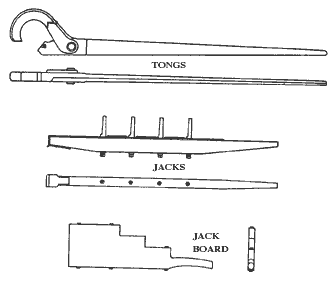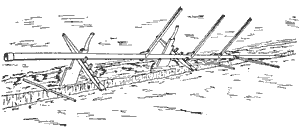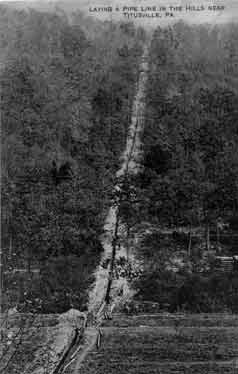 |
||||||
A Flurry of Pipelines
Besides the very early pipelines already discussed including some of those laid during the pipeline boom beginning late 1865, a great many lines were laid in the remainder of the 1860's and thereafter. Some of the pipelines were sudden events, their distance being short. The lower 16+ miles of Oil Creek Valley was filled with them and Oil City at the mouth was one of the hubs. But looking farther away than the first oil belt, early pipes of the 1860's were being laid in West Virginia, and thought about in other producing states.
From late 1865 into 1869 (the end of the first decade of oil) the following were among the many lines laid in the Pennsylvania oil region (Oil & Gas Journal, 1934, Derricks's Handbook of Petroleum, 1898).
|
1865 |
Rochester & Oleopolis Transportation Co. of Oil City (six-inch pipeline from Oleopolis to Oil City). |
||||||||||||
|
1866 |
Star Pipeline (a short line, West Pithole to Pithole City) |
||||||||||||
|
1866 |
Titusville Pipe Company (two two-inch lines in one ditch, Pithole to Titusville) |
||||||||||||
|
1866 |
Payne & Marten (short pipeline at Petroleum Centre in Oil Creek Valley) |
||||||||||||
|
1867 |
The Empire Transportation Co. (a number of short lines terminating at railroad facilities on Oil Creek) |
||||||||||||
|
1867-68 |
Vandergrift & Forman (they operated the following lines in Pennsylvania) |
||||||||||||
|
|||||||||||||
|
1868 |
Stephen D. Karns (first pipeline from Parker's Landing, Pa., to the railroad terminal on the opposite side of the Allegheny River) |
||||||||||||
|
1869 |
Karns & Parker Pipeline (Stephen D. Karns and Fullerton Parker built pipelines) |
||||||||||||
|
1869 |
Union Pipeline (this company was formed as a merger of Parker, Thompson & Co. and Karns & Parker Pipelines, both of which companies had briefly been rivals and at odds). |
There were also lines at Tidioute and Franklin and probably more short lines here and there during this period.
Authors title their chapters about the early history of pipelines with phrases such as: "Revolutionizing Transportation" (Giddens, 1938), and "From the Well to the Lamp" (McLaurin, 1896), "Oil Underground" and "The Pipelines Take Over" (Editors of LOOK, 1946) etc. A trip through the now nearly abandoned oil region in NW Pennsylvania will reveal great numbers of (oil or service) above-ground pipelines, many of which are short lines easily seen as bundles of pipes in the bottoms of the steep-sided ravines and depend on gravity flow. As many as a dozen or more old pipelines can be seen along the banks of incised creeks such as at the remains of the oilfields at Pithole, Point Hill (Franklin), Halyday Run and the Hogback (Oil City), Wildcat Hollow (Petroleum Centre). They are often very close to one-another and many are suspended from short lengths of pipe driven into the ground. Pipes of various diameters lying on the ground can be seen in the old Shamburg field. In general the early oil belt is laced with them. But they don't carry oil anymore, and they are not among the cadre of the pioneer oil lines. They date from the 1900's, many of them from the resurgence of stripper production during the Great War and World War II. Here and there, a black, yellow or orange plastic pipeline (looking out of place) will be seen near or along a bundle of the old ones. That means that somebody had brought a distant well back to production by pump jack in one of the short periods when the "price was right". Plastic has also replaced iron in oilfield tanks.
It isn't the intent of this chapter to bring a reader up-to-date (that would require several volumes). The emphasis here is on the beginnings of the pipelines in the 1860's. Booms have happened since then and the surviving pipes relate to one or more of them. The author has seen remnants of pipelines in the waters of Oil Creek and the Allegheny River, some of them badly rusted, full of holes, and holding not oil but pebbles which have lodged within them during times of fast currents.
|
||
|
||
|
![]()
| © 2004, Samuel T. Pees all rights reserved |
|


